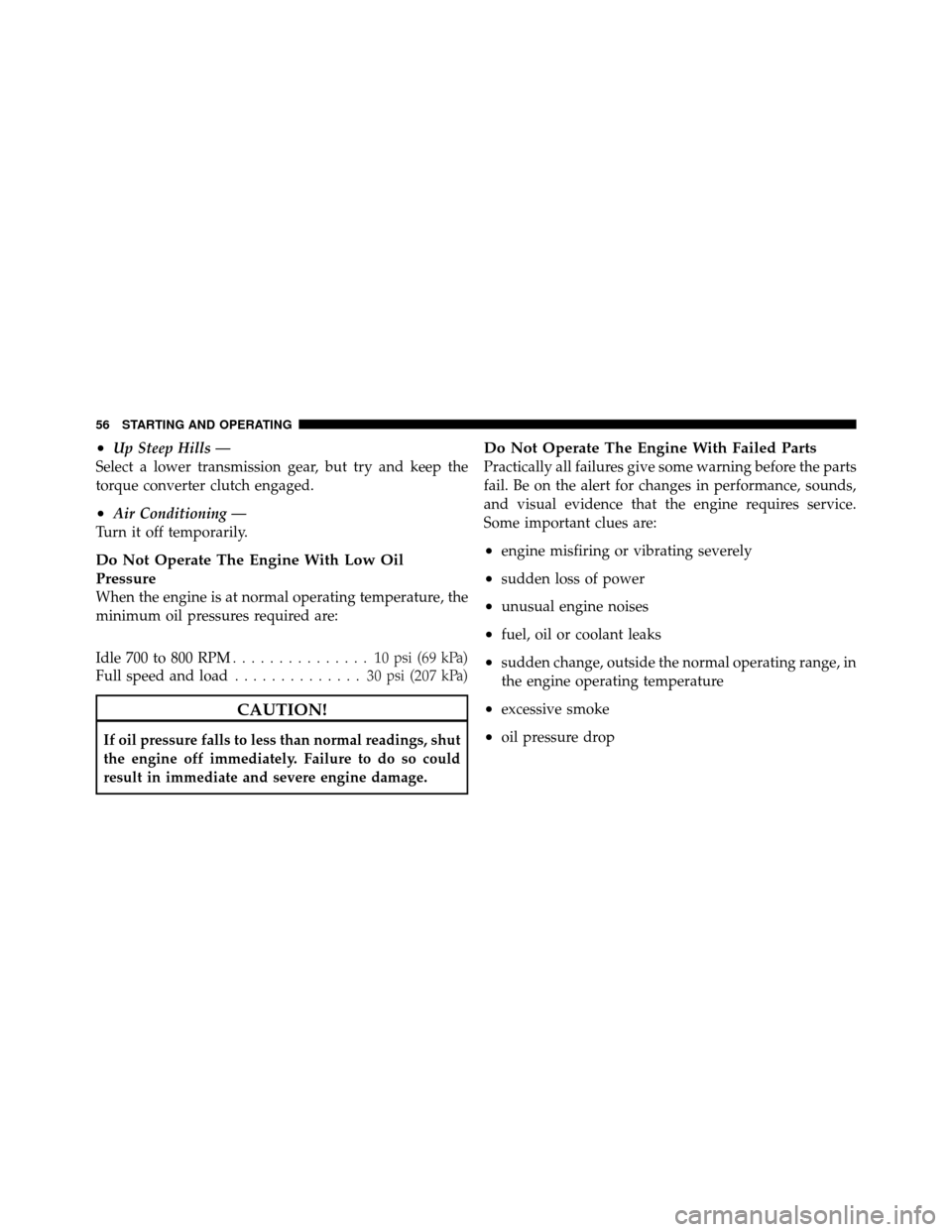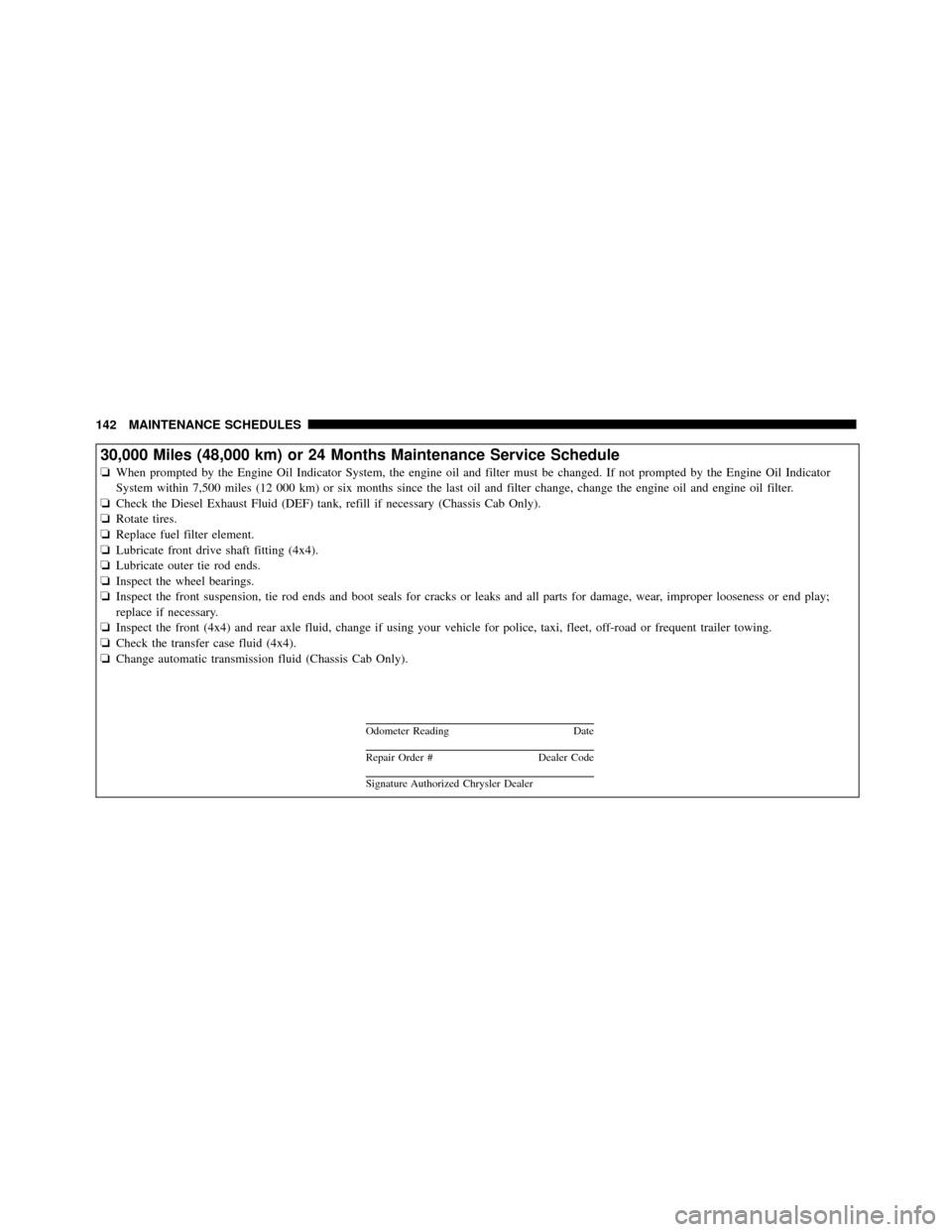Page 57 of 170

•Up Steep Hills —
Select a lower transmission gear, but try and keep the
torque converter clutch engaged.
•Air Conditioning —
Turn it off temporarily.
Do Not Operate The Engine With Low Oil
Pressure
When the engine is at normal operating temperature, the
minimum oil pressures required are:
Idle 700 to 800 RPM ............... 10psi(69kPa)
Full speed and load .............. 30psi (207 kPa)
CAUTION!
If oil pressure falls to less than normal readings, shut
the engine off immediately. Failure to do so could
result in immediate and severe engine damage.
Do Not Operate The Engine With Failed Parts
Practically all failures give some warning before the parts
fail. Be on the alert for changes in performance, sounds,
and visual evidence that the engine requires service.
Some important clues are:
•engine misfiring or vibrating severely
•sudden loss of power
•unusual engine noises
•fuel, oil or coolant leaks
•sudden change, outside the normal operating range, in
the engine operating temperature
•excessive smoke
•oil pressure drop
56 STARTING AND OPERATING
Page 96 of 170
MAINTAINING YOUR VEHICLE
CONTENTS
�Engine Compartment — 6.7L Diesel ......... 97
� Maintenance Procedures .................. 98
▫ Engine Oil .......................... 98
▫ Engine Air Cleaner Filter ............... 102
▫ Draining Fuel/Water Separator Filter ...... 104
▫ Priming If The Engine Has Run Out Of
Fuel .............................. 108
▫ Intervention Regeneration Strategy – EVIC
Message Process Flow ................. 109
▫ Diesel Exhaust Fluid – Chassis Cab Only . . . 112 ▫
Maintenance-Free Batteries ............. 112
▫ Cooling System ..................... 113
▫ Charge Air Cooler – Inter-Cooler ......... 119
▫ Brake System ....................... 119
▫ Clutch Hydraulic System ............... 121
▫ Transfer Case – If Equipped ............. 121
▫ Manual Transmission – If Equipped ....... 121
▫ Automatic Transmission – If Equipped ..... 122
▫ Noise Control System Required Maintenance
& Warranty ........................ 125
6
Page 98 of 170
ENGINE COMPARTMENT — 6.7L DIESEL
1 — Battery7 — Engine Oil Dipstick
2 — Engine Coolant Reservoir 8 — Washer Fluid Reservoir
3 — Automatic Transmission Dipstick (If Equipped) 9 — Engine Oil Fill
4 — Brake Fluid Reservoir 10 — Coolant Pressure Cap
5 — Clutch Master Cylinder (Manual Transmission Only) 11 — Air Cleaner Filter
6 — Integrated Power Module
6
MAINTAINING YOUR VEHICLE 97
Page 99 of 170

MAINTENANCE PROCEDURES
The pages that follow contain therequiredmaintenance
services determined by the engineers who designed your
vehicle.
Besides those maintenance items specified in the fixed
maintenance schedule, there are other components which
may require servicing or replacement in the future.
CAUTION!
•Failure to properly maintain your vehicle or per-
form repairs and service when necessary could
result in more costly repairs, damage to other
components or negatively impact vehicle perfor-
mance. Immediately have potential malfunctions
examined by an authorized Chrysler Group LLC
dealership or qualified repair center.
(Continued)
CAUTION! (Continued)
•Your vehicle has been built with improved fluids
that protect the performance and durability of
your vehicle and also allow extended maintenance
intervals. Do not use chemical flushes in these
components as the chemicals can damage your
engine, transmission, power steering or air condi-
tioning. Such damage is not covered by the New
Vehicle Limited Warranty. If a flush is needed
because of component malfunction, use only the
specified fluid for the flushing procedure.
Engine Oil
Checking Oil Level
To assure proper lubrication of your vehicle’s engine, the
engine oil must be maintained at the correct level. Check
the oil level at regular intervals. The best time to check
the oil level is before starting the engine after it has been
98 MAINTAINING YOUR VEHICLE
Page 123 of 170

Automatic Transmission – If Equipped
Lubricant Selection
Refer to “Fluids, Lubricants, and Genuine Parts” in
“Maintaining Your Vehicle” for further information.
Fluid Level Check – 68RFE (Ram Truck Only)
If your vehicle is equipped with a dipstick, use the
following procedure. If your vehicle has a capped dip-
stick tube, it is sealed and should not be tampered with.
Your authorized dealer has the proper tools to ensure that
the fluid level is set properly. The fluid level should be
checked when the engine is fully warmed up and the
fluid in the transmission is at normal operating tempera-
ture. Operation of the transmission with an improper
fluid level will greatly reduce the life of the transmission
and of the fluid. Check the fluid level whenever the
vehicle is serviced.
To properly check the automatic transmission fluid level,
the following procedure must be used:1. Operate the engine at idle speed and normal operating
temperature.
2. The vehicle must be on level ground.
3. Fully apply the parking brake and press the brake
pedal.
4. Place the shift lever momentarily into each gear posi-
tion ending with the shift lever in PARK.
5. Remove the dipstick, wipe it clean and reinsert it until
seated.
6. Remove the dipstick again and note the fluid level on
both sides. The fluid level should be between the “HOT”
(upper) reference holes on the dipstick at normal operat-
ing temperature. Verify that solid coating of oil is seen on
both sides of the dipstick. If the fluid is low, add as
required into the dipstick tube.
Do not overfill.After
adding any quantity of oil through the oil fill tube, wait
a minimum of two minutes for the oil to fully drain into
the transmission before rechecking the fluid level.
122 MAINTAINING YOUR VEHICLE
Page 125 of 170

3. Fully apply the parking brake and press the brake
pedal.
4. Place the shift lever momentarily into each gear posi-
tion ending with the shift lever in PARK. Make sure the
engine is running at idle speed.
5. Remove the dipstick and determine if the fluid is hot
or cold. Hot fluid is approximately 160°F to 175°F (70°C
to 82°C). This is the normal operating temperature after
the vehicle has been driven at least 15 miles (25 km). The
fluid cannot be comfortably held between the fingertips.
Only use the cold region of the dipstick as a rough
reference when doing initial oil level set after transmis-
sion rebuild or transmission refill.
6. Wipe the dipstick clean and reinsert it until seated.
7. Remove the dipstick again and note the fluid level on
both sides. The fluid level should be between the HOT(upper) reference holes on the dipstick at normal operat-
ing temperature. Verify that a solid coating of oil is seen
on both sides of the dipstick. If the fluid is low, add
MOPAR�
AS68RC Automatic Transmission Fluid or
equivalent as required into the dipstick tube. Do not
overfill. Never use any ATF other than MOPAR�
AS68RC Automatic Transmission Fluid or equivalent.
After adding any quantity of oil through the dipstick
tube, wait a minimum of two minutes for the oil to fully
drain into the transmission before rechecking the fluid
level.
NOTE: If it is necessary to check the transmission below
the operating temperature, the fluid level should be
between the two COLD (lower) holes on the dipstick
with the fluid at approximately 70°F to 85°F (20°C to
30°C). If the fluid level is correctly established at room
temperature, it should be between the HOT (upper)
reference holes when the transmission reaches 160°F to
175°F (70°C to 82°C).
124 MAINTAINING YOUR VEHICLE
Page 137 of 170

MAINTENANCE SCHEDULE
CAUTION!
Failure to perform the required maintenance items
may result in damage to the vehicle.
At Each Stop for Fuel
•Check the engine oil level at least 30 minutes after a
fully warmed engine is shut off. Checking the oil level
while the vehicle is on level ground will improve the
accuracy of the oil level reading. Add oil only when
the level is at or below the ADD or MIN mark.
Once a Month
•Inspect the batteries, and clean and tighten the termi-
nals as required.
•Check the fluid levels of the coolant reservoir, brake
master cylinder, and transmission and transfer case (if
equipped), add as needed.
At Each Oil Change
•Change the engine oil filter.
•Inspect the exhaust system.
•Check the automatic transmission fluid level (if
equipped).
•Check the manual transmission fluid level (if
equipped).
•Check the coolant level, hoses, and clamps.
•Lubricate outer tie rod ends.
Inspection and service should also be performed anytime
a malfunction is observed or suspected. Retain all re-
ceipts.
136 MAINTENANCE SCHEDULES
Page 143 of 170

30,000 Miles (48,000 km) or 24 Months Maintenance Service Schedule
❏When prompted by the Engine Oil Indicator System, the engine oil and filter must be changed. If not prompted by the Engine Oil Indicator
System within 7,500 miles (12 000 km) or six months since the last oil and filter change, change the engine oil and engine oil filter.
❏ Check the Diesel Exhaust Fluid (DEF) tank, refill if necessary (Chassis Cab Only).
❏ Rotate tires.
❏ Replace fuel filter element.
❏ Lubricate front drive shaft fitting (4x4).
❏ Lubricate outer tie rod ends.
❏ Inspect the wheel bearings.
❏ Inspect the front suspension, tie rod ends and boot seals for cracks or leaks and all parts for damage, wear, improper looseness or end play;
replace if necessary.
❏ Inspect the front (4x4) and rear axle fluid, change if using your vehicle for police, taxi, fleet, off-road or frequent trailer towing.
❏ Check the transfer case fluid (4x4).
❏ Change automatic transmission fluid (Chassis Cab Only).
Odometer Reading Date
Repair Order #Dealer Code
Signature Authorized Chrysler Dealer
142 MAINTENANCE SCHEDULES